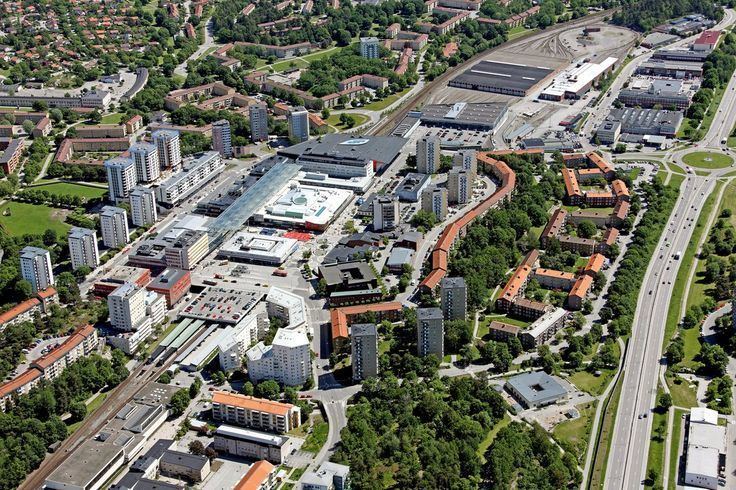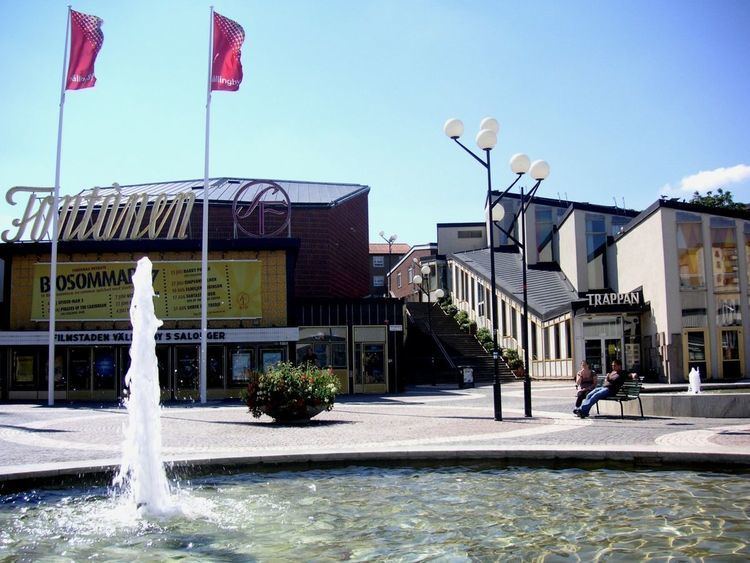Local time Wednesday 2:34 PM | ||
 | ||
Weather 11°C, Wind W at 29 km/h, 38% Humidity | ||
Vällingby ([ˈvɛllɪŋˌbyː]; by most Swedes today understood as "Gruel Village", see history below) is a suburban district in Västerort in the western part of Stockholm Municipality, Sweden.
Contents
- Map of VC3A4llingby HC3A4sselby VC3A4llingby Stockholm Sweden
- Omrdesfilm Vallingby Hasselby
- History
- Renovation
- Notable natives
- References
Map of V%C3%A4llingby, H%C3%A4sselby-V%C3%A4llingby, Stockholm, Sweden
Vällingby was planned in the early 1950s as a new town. Following its inauguration in 1954, it soon became world famous as a unique, well-planned city district served by the Stockholm Metro and a symbol of the Swedish middle-way welfare state.
Områdesfilm Vällingby Hässelby
History

The agricultural land where the modern suburb now stands, has a history stretching some 2,000 years back (i.e. at least twice as old as Stockholm). The people who lived there were known as vaellingar, "those living on the embankment". While it first appears in historical records in 1347 and it is known two farmyards existed here during the reign of King Gustav Vasa in the 16th century, in the 1922 edition of Nordisk Familjebok the location was still regarded as too insignificant to deserve an article. In 1953 the number of inhabitants barely exceeded 2,000.
In a few years this rural land was transformed into the present modern suburb, inaugurated in 1954 in a ceremony attracting some 75,000 people. Vällingby was the first "ABC City" — an acronym for Arbete - Bostad - Centrum, "Labour - Housing - Centre" — a suburb designed to offer its residents everything they needed, in short an independent city. High above the modern structure a rotating V-symbol placed the project on the map, while the shining T-symbol (for tunnelbana, metro) proudly indicated the presence of the newly built Stockholm Metro. Shortly after the inauguration of the modern suburb the number of inhabitants had reached 25,000.
The new suburb was the fruit of plans to exploit the rural areas surrounding Stockholm dating back to the early 20th century. As a direct consequence of real-estate speculations around the turn of the century 1900, centralised municipal city planning was widely accepted as a necessary tool to solve the acute housing shortage and the City of Stockholm bought large areas for the purpose. During the decades preceding the construction of Vällingby, a series of small-scale suburbs had been realised: Some more or less exclusive — such as the egnahemsområden ("own-your-own-home areas") at Stocksund and Saltsjöbaden built around 1900; or in the style of the Garden City, like in Bromma and Enskede built between the wars; and low blocks of apartments built during the 1940s, like in Traneberg and Abrahamsberg.
However, many of these suburbs had turned into dormitory suburbs, a problem thought to be avoided in Vällingby by planning for approximately 10,000 work places for the 20-25.000 inhabitants, while the metro was to provide access to the commercial centre to some 80,000 people. Important influences came from the United Kingdom where both Labour and the Tories launched ambitious welfare programmes. The original plan for the area was designed by architect Sven Markelius who placed high-rise buildings near the metro stations with peripheral self-contained houses and green areas around it. While the Social Democrats are widely acknowledged for the realisation of Vällingby, other political parties and, not the least, private entrepreneurs actively took part in the planning process. Additionally, Vällingby became an important piece of propaganda used to spread an image of harmonic Swedish welfare all over the world.
However, the ABC City failed to work as intended as most people found work elsewhere. Nevertheless, Vällingby remains one of the most popular suburbs of Stockholm with a cultural significance unsurpassed by later suburbs built as part of the so-called Million Programme during the 1960s and 1970s, such as Skärholmen and Tensta, where less efforts were spent on cultural and social infrastructure. Vällingby appeared in the novel and its film adaption "Let the Right One In".
Renovation
Ever since the late-1980s, a plan to renovate the main centre of Vällingby has been discussed. Only in the beginning of the year 2001 was the plan finally accepted by the local political powers. The major redevelopment of the centre was finished and inaugurated officially in April 2008.
